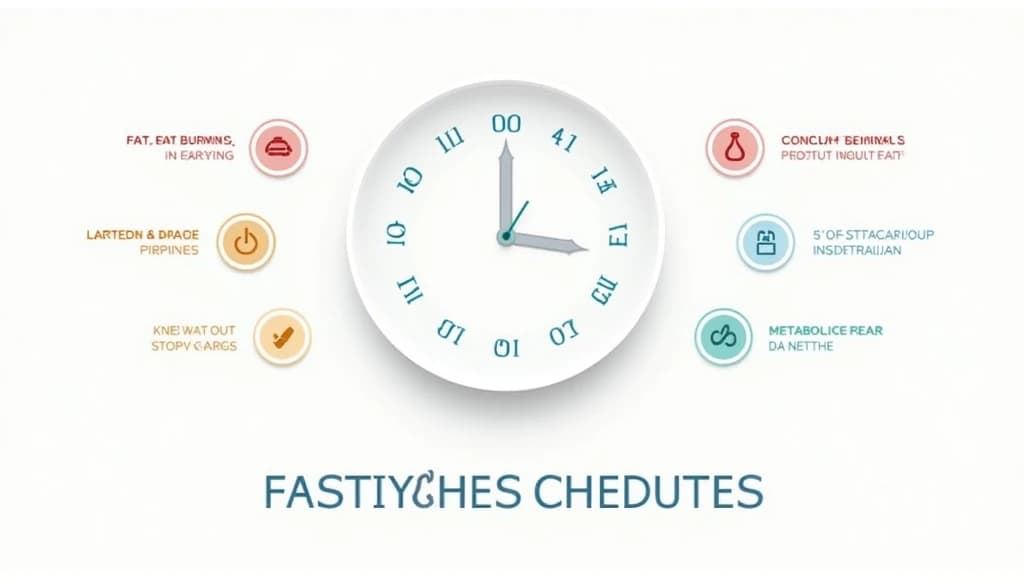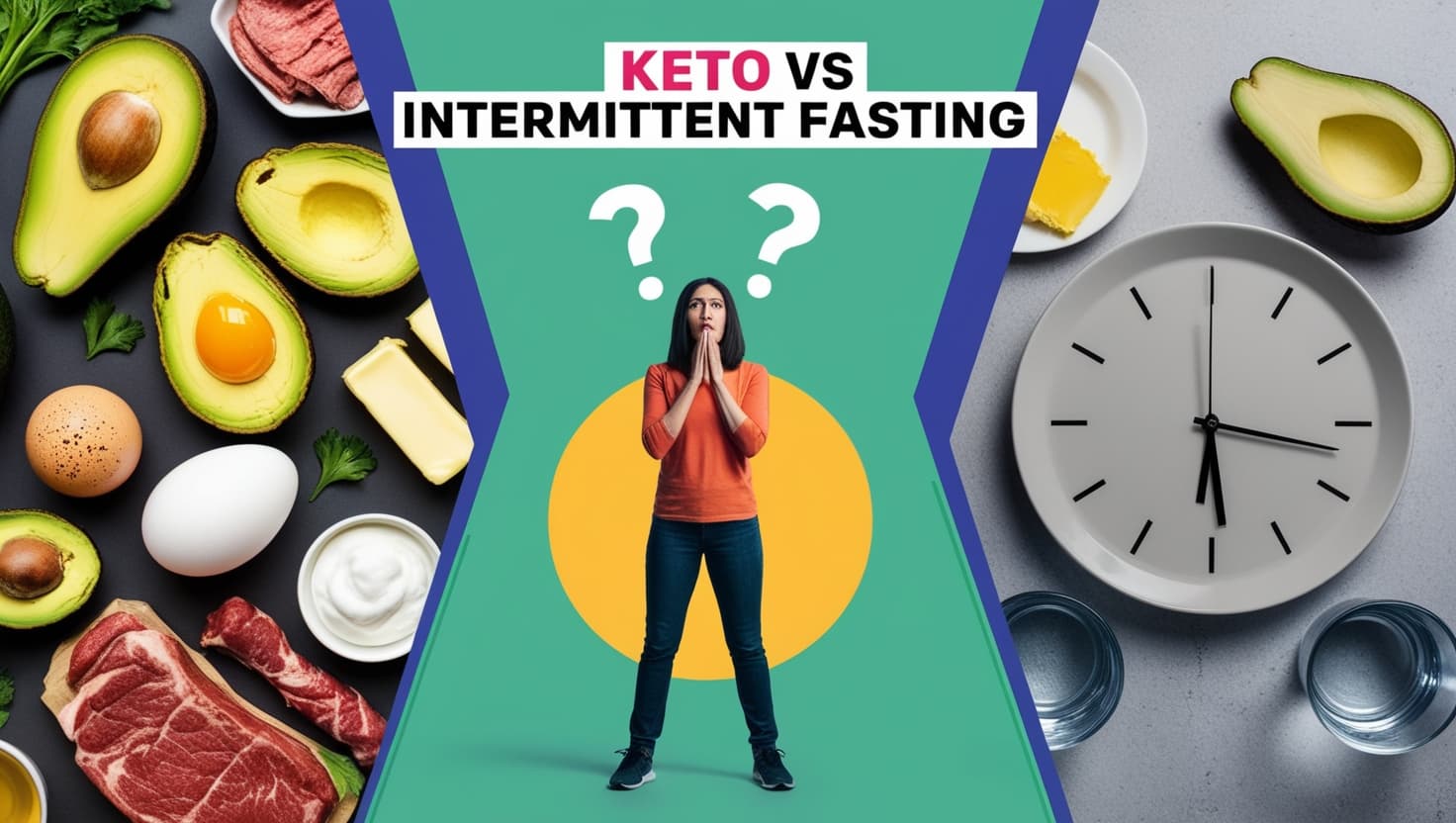Table of Contents
ToggleHave you ever found yourself staring at the scale, frustrated and confused about why your current diet isn’t working? Or maybe you’re torn between two of the most popular lifestyle changes sweeping the health industry: Keto vs Intermittent Fasting. Both claim to help you shed pounds, improve your health, and boost energy, but which one is right for you? The answer may not be as straightforward as you think.

In this in-depth guide, we’ll compare Keto and Intermittent Fasting (IF), helping you understand the core principles, benefits, and potential drawbacks of each. By the end, you’ll have the insight to make an informed decision that aligns with your health goals and lifestyle.
What Is the Keto Diet?
The Ketogenic (Keto) diet is a high-fat, low-carbohydrate eating plan designed to shift your body from burning glucose (carbohydrates) for energy to burning fat. This metabolic process is called ketosis, where the body breaks down fat into ketones to fuel your brain and muscles.
How Does Keto Work?
On a traditional diet, carbohydrates are the body’s primary energy source. When you eat carbs, your body converts them into glucose, which your cells use for energy. However, when you severely restrict carbs (usually to under 50 grams per day), your body has to find an alternative energy source—fat. This process, called ketogenesis, leads to a state of ketosis, where your body relies on stored fat to generate energy.
Benefits of the Keto Diet
- Weight Loss: Keto is highly effective for rapid fat loss, particularly in the first few weeks of starting the diet.
- Appetite Control: Many people report feeling less hungry on Keto, as fats are more satiating than carbs.
- Improved Blood Sugar Control: Keto helps to stabilize blood sugar levels, which is beneficial for those with insulin resistance or type 2 diabetes.
- Increased Mental Clarity: Some claim they experience sharper focus and better cognitive performance when in ketosis.
- Heart Health: Despite its high-fat nature, studies suggest Keto can improve heart health by reducing triglycerides and increasing HDL (good cholesterol) levels.
Drawbacks of the Keto Diet
- Keto Flu: When transitioning into ketosis, many experience flu-like symptoms, including headaches, fatigue, and irritability.
- Strictness: The diet requires meticulous tracking of carbs and can be difficult to maintain long-term.
- Nutrient Deficiency: A low-carb diet may lack essential nutrients, including fiber, vitamins, and minerals if not properly balanced.
- Social Restriction: Dining out or attending social events can become challenging since many common foods are high in carbs.
What Is Intermittent Fasting (IF)?

Intermittent fasting is less about what you eat and more about when you eat. It involves cycling between periods of eating and fasting, with the goal of optimizing your body’s natural fat-burning abilities.
How Does Intermittent Fasting Work?
By restricting the time you eat, intermittent fasting helps your body tap into fat stores for energy during fasting periods. When you fast, insulin levels drop, allowing your body to burn stored fat more efficiently. Additionally, fasting triggers cellular repair processes, such as autophagy, where your body clears out damaged cells and regenerates healthier ones.
Types of Intermittent Fasting
- 16/8 Method: This method involves fasting for 16 hours and eating within an 8-hour window (e.g., noon to 8 PM).
- 5:2 Diet: Eat normally for five days and restrict calories to around 500-600 for two non-consecutive days.
- Eat-Stop-Eat: Involves fasting for a full 24 hours once or twice a week.
- Alternate-Day Fasting: You alternate between eating normally one day and consuming very few calories the next.
Benefits of Intermittent Fasting
- Weight Loss: By reducing your eating window, many people naturally consume fewer calories, leading to fat loss.
- Improved Metabolic Health: Fasting can improve insulin sensitivity, lower blood sugar levels, and potentially reduce the risk of type 2 diabetes.
- Cellular Repair: Fasting triggers autophagy, which is thought to help protect against diseases like Alzheimer’s and cancer.
- Longevity: Some studies suggest intermittent fasting may extend lifespan by improving overall cellular health and reducing oxidative stress.
- Simplicity: Unlike Keto, intermittent fasting doesn’t require you to track macronutrients or follow a strict meal plan.
Drawbacks of Intermittent Fasting
- Hunger: Fasting periods can be challenging, particularly in the early stages.
- Social Interference: Like Keto, fasting can affect your social life, especially around meal times.
- Potential for Overeating: Some people may compensate for fasting by overeating during their eating window.
- Energy Dips: Fasting might leave you feeling fatigued, especially during the adjustment period.
Keto vs Intermittent Fasting: Key Differences

1. Focus on Food vs Time
- Keto revolves around what you eat—particularly focusing on limiting carbs and increasing fats.
- Intermittent fasting focuses on when you eat, without restricting specific food types (although healthier whole foods are encouraged for better results).
2. How They Affect Insulin
- Keto lowers insulin levels by reducing carbohydrate intake, which means less glucose in the bloodstream.
- Intermittent fasting reduces insulin by extending periods without food, giving your body time to burn through glucose stores.
3. Ease of Integration into Lifestyle
- Keto requires a strict adherence to macronutrient ratios, which can be time-consuming and restrictive.
- Intermittent fasting is generally easier to fit into your lifestyle, as you only need to adjust meal timings rather than the types of food you consume.
4. Long-Term Sustainability
- Keto can be difficult to maintain in the long term due to its rigid structure and the potential for missing out on key nutrients.
- Intermittent fasting, on the other hand, is often seen as more sustainable since it doesn’t require as many dietary restrictions.
Can You Combine Keto and Intermittent Fasting?
Yes, many people combine Keto and Intermittent Fasting for enhanced benefits. By doing so, you can potentially accelerate your entry into ketosis and burn fat more efficiently. Intermittent fasting helps deplete glycogen stores faster, pushing your body into fat-burning mode more quickly, which aligns well with the goals of Keto.
Benefits of Combining Keto and Intermittent Fasting
- Faster Ketosis: Fasting can help you enter ketosis more quickly by using up glycogen stores.
- Enhanced Weight Loss: Both methods are effective for weight loss, and combining them may lead to faster results.
- Improved Mental Clarity: Many people report heightened focus and mental sharpness when combining the two approaches.
- Better Insulin Sensitivity: Both fasting and keto have been shown to improve insulin sensitivity, which can be effective for managing diabetes and metabolic syndrome.
Potential Drawbacks of Combining Keto and IF
- Increased Difficulty: Combining both approaches requires significant discipline and can be harder to maintain.
- Risk of Nutrient Deficiency: When restricting both food types and meal times, you risk not getting enough essential vitamins and minerals, unless you’re careful about nutrient-rich food choices.
Which Is Better for Weight Loss?

Both Keto and Intermittent Fasting are effective for weight loss, but the best choice depends on your personal preferences and lifestyle.
- Keto is often faster for initial weight loss due to the dramatic reduction in carbs and the diuretic effect of ketosis.
- Intermittent fasting may be easier for long-term weight management, as it’s less restrictive and focuses on meal timing rather than specific food choices.
If you’re looking for faster, more immediate results and don’t mind a strict diet, Keto may be the better choice. However, if you prefer more flexibility in what you eat and want a plan that’s easier to sustain, intermittent fasting might be more suitable.
Which Is Better for Health?
Both diets offer significant health benefits, but they differ in their approach:
- Keto is beneficial for improving blood sugar control and may help with neurological conditions like epilepsy.
- Intermittent fasting has been shown to improve longevity, enhance cellular repair, and potentially reduce the risk of age-related diseases.
For overall health, intermittent fasting may provide more long-term benefits, particularly when it comes to longevity and metabolic health.
Conclusion
Choosing between Keto and Intermittent Fasting depends on your specific goals, preferences, and lifestyle. Both have proven benefits for weight loss, metabolic health, and overall well-being, but they differ in their approach and ease of implementation. If you prefer structure and faster results, Keto might be your best bet. On the other hand, if you value flexibility and simplicity, intermittent fasting could be the way to go. Ultimately, the best diet is the one you can stick to long-term while still enjoying a healthy, balanced life.
Frequently Asked Questions (FAQ)
Can I do Keto and Intermittent Fasting together?
Yes, combining both can enhance fat burning and accelerate ketosis. However, it requires discipline and careful planning.
Which is better for beginners—Keto or Intermittent Fasting?
Intermittent fasting is usually easier for beginners as it doesn’t require strict macronutrient tracking like Keto.
Will I lose muscle on Keto or Intermittent Fasting?
No, when done correctly, both approaches can help preserve muscle mass, especially when paired with strength training.
Can I drink coffee while doing Keto or Intermittent Fasting?
Yes, black coffee is allowed on both diets. Just avoid adding sugar or high-carb creamers.
What are the side effects of Keto and Intermittent Fasting?
Keto can cause “Keto flu” and nutrient deficiencies, while intermittent fasting may lead to hunger and fatigue during the adjustment phase.





